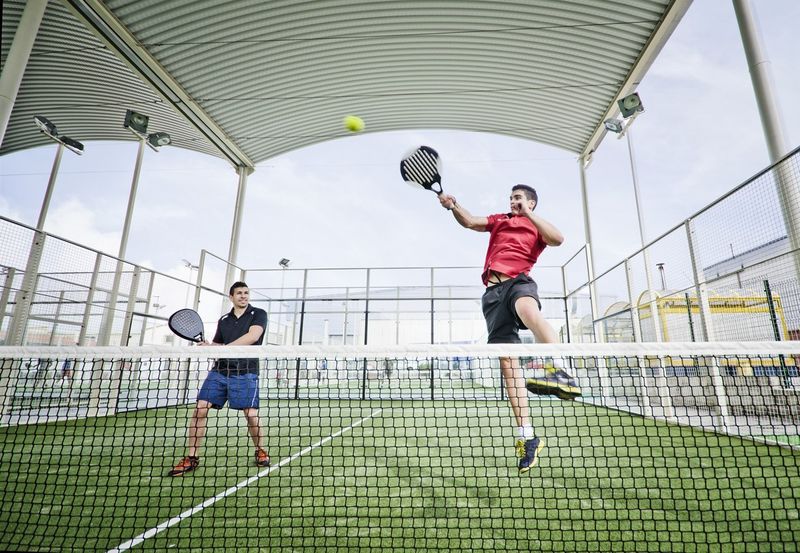
Construction and installation of a Padel Tennis Court in Miami Florida


Installation of 2 padel courts field to New York City
Univers Gazons has created to New York City at the Arena complex 2 5v5 football fields and 2 classic padel courts.Padel is booming in USA, more and more courts are being built.Many new complexes are emerging by combining several sports practices and the construction of padel is more and more ... More detailsnavigate_next
Installation de 4 terrains de foot indoor to New York City
Univers Gazons has installed 4 indoor soccer fields measuring 15 mx 25 m with high-end services:- Infrastructure composed of 80 x 40 black powder coated galvanized steel module and 12 mm tempered glass- Glass has many advantages, it is much more solid over time, it increases the luminosity in the... More detailsnavigate_next
Indoor soccer installation and conception to New York USA
Univers offers you infrastructures and synthetic turf specially designed for indoor or outdoor 5-a-side football.To learn more about our products Click hereYou have the project to open an indoor football whether you are from Nice, Bordeaux or Nice, you can contact Mr SAUCLES MARC send us an email... More detailsnavigate_next
Installation of synthetic turf for indoor football Detroit Michigan
Univers lawns manufacturer and installer of indoor football has replaced the synthetic turf of 2 fields of 15 mx 28 m for the “Big Foot” 5-a-side football center in Detroit Michigan.To do this we used a high-end synthetic turf with 50 mm thick infill.This latest generation artificial lawn with sha... More detailsnavigate_next
manufacturer of latest generation indoor football Chicago Illinois, indoor football infrastructure and synthetic turf
Univers lawns manufacturer and installer of indoor football offers a complete solution in your indoor football creation.All our structures are custom-made according to the size of your warehouse in order to optimize as much space as possible.We propose :- a high-end infrastructure composed of... More detailsnavigate_nextConstruction and Installation of a New Padel Court
Creating a new, high-quality Padel court involves a systematic construction and installation process. Clubs and sports facilities embarking on this exciting project must meet specific construction requirements to provide a good playing experience for their members, all while adhering to a solid base system.
Base Preparation: The foundation of a Padel court is crucial, and it starts with selecting a solid base. A well-constructed base system forms the bedrock of the entire project, ensuring stability and durability.
Club Integration: The new Padel court should seamlessly integrate into the existing club facility, complementing other amenities. This integration enhances the overall club experience and encourages tennis players and new enthusiasts to explore Padel.
Construction Expertise: A good construction team with experience in Padel court installation is essential. Their knowledge ensures that the court meets the required standards and regulations, creating a safe and enjoyable playing environment.
Quality Assurance: To maintain a high-quality facility, the construction project must adhere to rigorous quality assurance procedures. This includes regular inspections and adherence to construction guidelines.
Cost Considerations: While quality is paramount, cost-effectiveness is also important. Clubs often seek financing options to make the construction project feasible.
By following these construction and installation guidelines, clubs and sports facilities can introduce a new Padel court to their offerings, attracting new players and providing a free and enjoyable sports experience.
Part 1: Introduction to Padel Tennis Court Installation
a. What is Padel?
Padel is a thrilling racquet sport that is rapidly gaining popularity in the United States. Combining elements of tennis and squash, Padel is played on an enclosed court with glass walls, offering a dynamic and engaging playing experience for enthusiasts of all skill levels.
b. Why Padel is becoming popular in the US?
The popularity of Padel in the US can be attributed to its accessibility and social nature. Unlike traditional tennis, Padel courts are smaller, which allows for longer rallies and more engaging gameplay. Additionally, Padel's rules permit the ball to be played off the walls, adding an exciting dimension to the sport.
c. The benefits of Padel over traditional tennis
Padel offers several advantages over traditional tennis. It is easier to learn, making it accessible to beginners, while still providing a challenge for seasoned players. The smaller court size promotes faster-paced and more interactive matches, making it a great social sport. The enclosed court design also means that wind and sun conditions have less impact on gameplay.
d. The growing demand for Padel courts in the US
The US is experiencing a surge in demand for Padel courts as more people discover the sport's unique appeal. Padel court installation projects are popping up across the country to meet this demand. As the sport continues to grow, there is a need for comprehensive planning, construction, and maintenance of Padel courts.
Part 2: Planning and Construction of Padel Courts
a. Choosing the right location for Padel court installation
Selecting the ideal location for a Padel court is crucial. Factors such as accessibility, visibility, and proximity to target players should be considered. A central location that caters to a diverse population can maximize court usage.
b. Factors to consider in the planning stage
In the planning stage, several critical factors must be addressed:
i. Size and dimensions of the court: Padel courts have specific dimensions that must be adhered to for official play. These dimensions ensure fair and exciting gameplay.
ii. Type of surface: The choice between artificial turf, asphalt, or sand depends on factors like climate, maintenance requirements, and player preferences.
iii. Subfloor and playing surface materials: The subfloor's quality and materials used for the playing surface impact the court's performance and durability.
c. Construction process and timeline
The construction process involves several key steps:
i. Groundwork and foundation preparation: Proper groundwork and foundation preparation are essential for a stable court structure.
ii. Court construction and installation: Skilled professionals are needed to assemble the court, including walls, fencing, and playing surface.
iii. Safety considerations and regulations: Ensuring the court complies with safety regulations is crucial to protect players and spectators.
d. Cost estimation and financing options
Estimating the project cost is vital for planning. Factors affecting the total cost include court size, surface type, and additional features. Various financing options and funding opportunities, such as grants or partnerships, can help make the project financially viable.
Part 3: Maintenance and Management of Padel Courts
a. Regular maintenance and upkeep of the court
To ensure the longevity and safety of a Padel court, regular maintenance is essential. This includes cleaning and grooming the playing surface, checking for damages or wear, and ensuring optimal playing conditions.
b. Additional amenities and features for a great Padel experience
Enhancing the Padel court experience involves considering amenities like fencing and enclosure systems, appropriate lighting for indoor and outdoor courts, factors affecting ball bounce and grip, and warranties from suppliers to maintain quality standards.
c. Partnership with Padel court experts and consultants
Choosing the right supplier or consultancy with expertise in Padel court installation is crucial. Their experience and guidance ensure that the court meets the highest standards of quality, safety, and performance.
d. Promoting and marketing the Padel court facility
Effective promotion and marketing are key to attracting players and members. Leveraging social media, building partnerships with local sports organizations, and hosting events and tournaments can drive interest and participation in Padel.
Univers Gazons remains at your disposal to present its know-how in matters of sports coating and construction of structure for the practice of padel, indoor soccer, etc.
Our experts study all your needs and carry out the installation of artificial turf for a football field on Miami Florida, the installation of artificial turf for putting green of golf , etc.
We manufacture our coatings and guarantee a high-end service. We can offer you the construction of an indoor soccer field, padel and multisport structure.
Contact us for more information on our different services.
Miami Florida
Construction and installation of a Padel Tennis Court in




